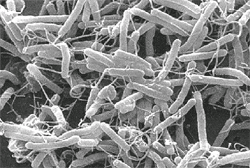Ulcerous!
 not very long ago, scientists disproved the widely held belief that it is not curry, worry and hurry that cause stomach ulcers but the wily bacterium Helicobacter pylori . This germ has since been implicated in a wide variety of gastrointestinal diseases from stomach inflammation to ulcers and even cancer. In developed countries, half the people over 50 years old carry the bacterium in their guts, and in developing countries, virtually everyone is exposed. Several animals may harbour the microorganism, but so far, no one has found a reservoir in the environment.
not very long ago, scientists disproved the widely held belief that it is not curry, worry and hurry that cause stomach ulcers but the wily bacterium Helicobacter pylori . This germ has since been implicated in a wide variety of gastrointestinal diseases from stomach inflammation to ulcers and even cancer. In developed countries, half the people over 50 years old carry the bacterium in their guts, and in developing countries, virtually everyone is exposed. Several animals may harbour the microorganism, but so far, no one has found a reservoir in the environment.
Now, a research team headed by Katherine H Baker from the department of environmental microbiology at Penn State University in Harrisberg, usa , has found a direct link between wellwater contaminated with H pylori and stomach ulcers. While there is epidemiological evidence supporting drinking water as a route of transmission of this organism, this is the first to demonstrate a direct link between contaminated drinking water and stomach ulcers.
The growing number of people with ulcers is a cause of serious concern and attempts are on to check this. As many as 2.5 million new H pylori infections occur each year in the us . The treatment costs exceed us $4 billion each year. What is more, about 16,000 deaths are attributed annually to complications of peptic ulcer disease. As there is no method at present for direct culture of H pylori from environmental samples, Baker's team had to develop two independent indirect methods of detection for this organism. As they were venturing into a new area with wide public health implications, they wanted to enhance the reliability of their data. Baker points out that the likelihood of both methods giving false positive results on a sample is extremely minimal.
The researchers surveyed 40 surface water and 33 groundwater samples in Central Pennsylvania for the presence of H pylori . Significantly, the ulcer-causing germ was associated with the total load of coliform organisms, but not with another bacterium, Escherichia coli . Both total coliforms and E coli are used as indicators for the purity of drinking water with regard to microbes. The presence of H pylori , in the absence of E coli , is a cause for concern. "What this really means is that our current methods for testing drinking water may be indicating that the water is fine while H pylori may actually be present,' notes Baker. She is reluctant to generalise her findings as her samples did not include municipal water supplies where it is likely that disinfection processes eliminate the organism from the water.
In a small number of samples, the research team was able to obtain clinical data (diagnosis of peptic ulcers) from residents consuming the water in addition to wellwater samples. There was a statistically significant correlation between the presence of H pylori in wellwater samples and clinical infection. While Baker stresses that the results of this study are preliminary, she notes that the likelihood of finding results like this at random are extremely small. The researchers, therefore, argue for an urgent need to develop additional rapid and easy methods for the detection of H pylori in drinking water as also for extensive surveys of drinking water supplies.
In another significant study, Donald Reid and his colleagues at the Robert Gordon University in Aberdeen, Scotland, report that the slime that coats water pipes could be a haven for H pylori . They report that the bacterium might thrive in biofilms that form when microorganisms colonise surfaces such as the insides of water pipes, often surrounding themselves with a sticky protective film. According to Reid, biofilms occur naturally in all water distribution systems the world over.
The researchers grew a biofilm inside stainless steel pipes in the laboratory and inoculated it with H pylori . Even after unchlorinated water was flushed through the pipes for 192 hours, Helicobacter pylori still infested the biofilm.
Although most public water supplies in developed countries are chlorinated, Reid believes the bacteria could still survive inside the biofilm. "Chlorine is only going to attack the upper layers. By the time those are destroyed, the chlorine is gone,' he says. As the biofilm builds up, Reid says that bacteria may be washed away a few at a time or occasionally released as large clumps. A spokesperson of one of the largest suppliers of drinking water in Britain, acknowledged that H pylori testing is not included in routine testing of treated water.
Related Content
- Report on the accident at M/s Sainor Life Sciences, Visakhapatnam, Andhra Pradesh, 26/10/2020
- Traditional uses of under-utilized tree species in sub tropical rainfed areas of Kathua, Jammu & Kashmir
- ‘Noise biggest enemy of traffic cops, affects entire body’
- Emergence of epizootic ulcerative syndrome: large-scale mortalities of cultured and wild fish species in Uttar Pradesh, India
- Social sciences research on infectious diseases of poverty: Too little and too late?
- Renal failure, gastric ulcer alarmingly common: Study
